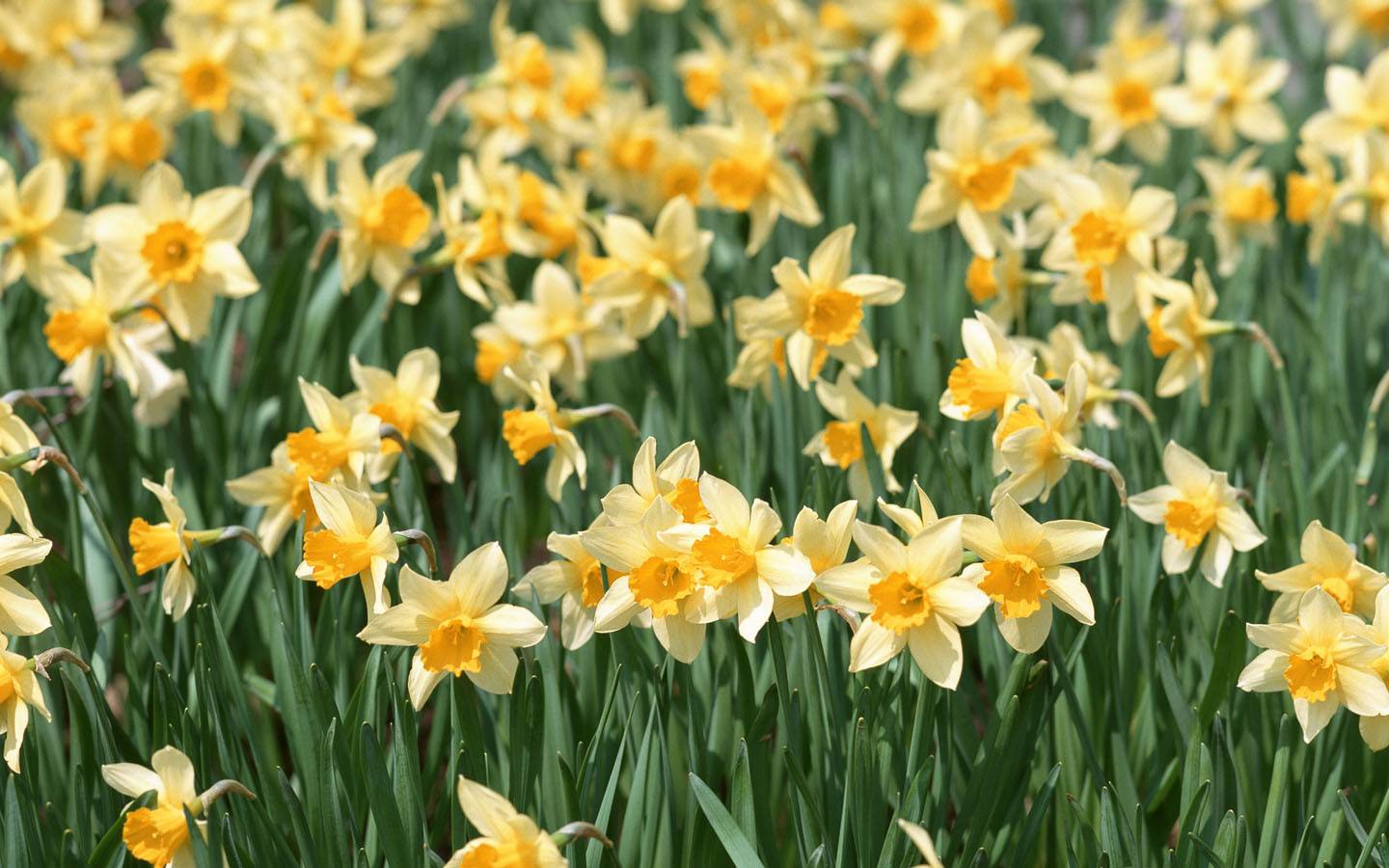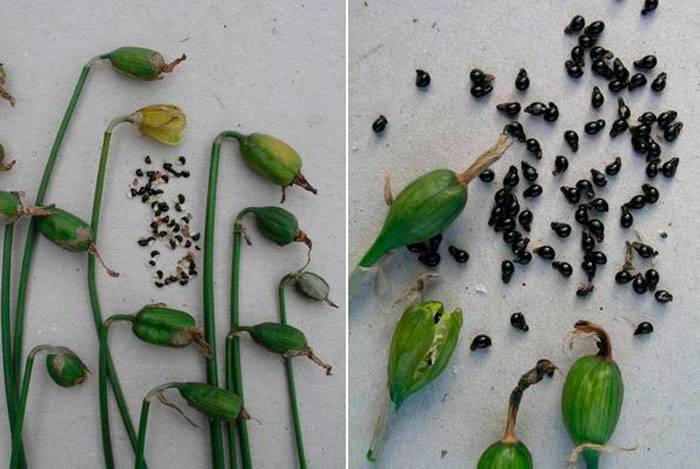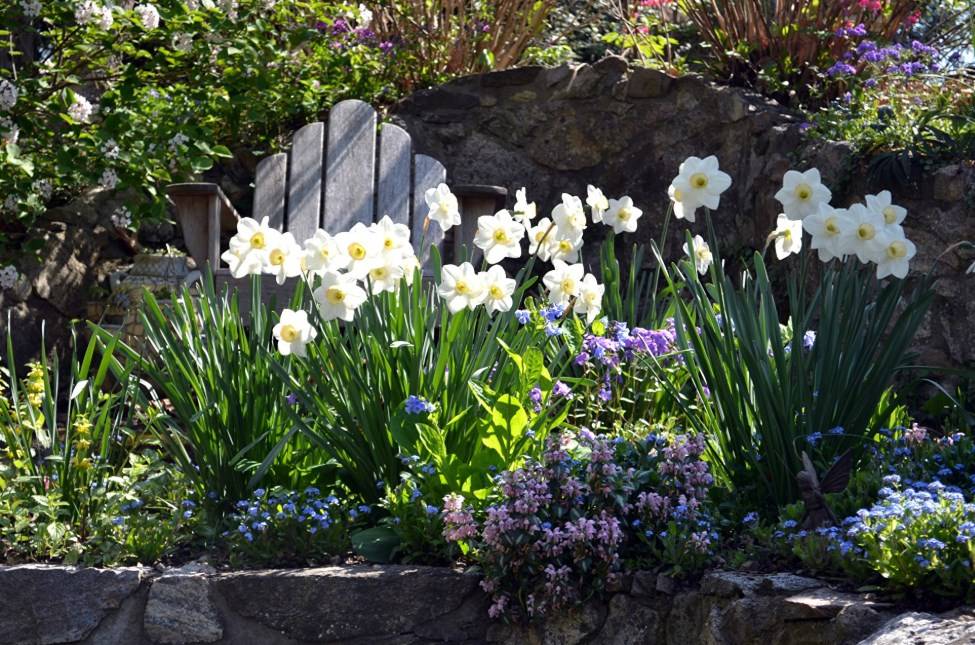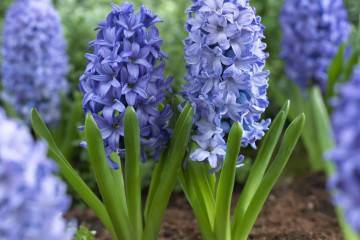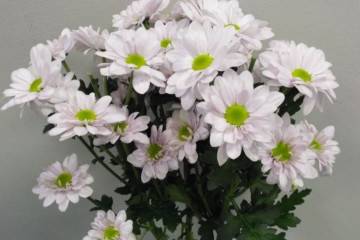Daffodils planting and care in the open field
Content:
Daffodils grow on many household plots, planting and caring in the open field does not create much trouble for the gardener. The flowering plant perfectly tolerates wintering and begins to actively awaken, germinate with the first warming.
Narcissus - what kind of garden flower is it, what family does it belong to?
Daffodils are representatives of the Amaryllis family, are perennial herbaceous species and varieties. Their indisputable advantages include endurance and unpretentiousness.
When flowering, a round or compressed bud is formed on a bare peduncle. Flowers can be single or collected in a brush, depending on the variety. The diameter of the flowers is no more than 6 cm.
The surface of the petals can be either ordinary or terry. Color - yellow or white. The perianth is characterized by the presence of an elongated cylindrical tube with a tubular, bell-shaped or cup-shaped crown.
How daffodils breed
There are two ways to grow a flowering culture: by jigging or by seeds. The first method is mainly used, for its implementation it is necessary to separate the small ones from the mother bulb. It is possible to plant them in a vegetative way only if the plant is older than three years. During this time, the scales have time to dry, so that they can be divided into parts.
As mentioned earlier, you can plant seeds at home, but this method is less common. For implementation, you need to sow undried ripe seeds in a pot, any plastic container, or open ground. The culture will begin to bloom no earlier than five years later.
Basic landing rules
A fairly common question among beginners and experienced gardeners is when to transplant daffodils after flowering. Having figured out when to plant or transplant daffodils, you need to familiarize yourself with the features of the process. If you do not prepare and strictly follow the step-by-step algorithm, the plant may not take root and die.
Daffodils are primroses, it is important to consider this when propagating and caring for the plant. Particular attention is paid to the selection of the site. The site must be sunny, and the soil should be light, nutritious and breathable.
Daffodils grow poorly in areas where tulips, lilies, phloxes, chrysanthemums, perennial asters and other bulbs previously grew. If earlier cucumbers, nightshades, cereals and legumes grew on the site, then daffodils will feel comfortable.
The bulbs are transplanted into open soil with the onset of warmth (in the spring in April-May or early summer). When choosing planting material, it is important to make sure that the bulbs are healthy - not weakened and soft, there are no signs of rot. The most appropriate time to purchase planting material is three months after flowering.
Experienced agronomists do not recommend purchasing planting material:
- with the formed sprout;
- in the springtime;
- multi-peaked (the presence of one large onion, and the rest are too small);
- the planting material was removed from the soil during flowering or shortly after completion, along with flowers, root particles and shoots.
Before planting in open soil, it is important to ensure that the bulbs are not soft and that there are no signs of disease or insect infestation. Planting material, which will pass a careful selection, must be additionally processed by immersing a solution of a fungicide preparation or potassium manganese for about half an hour.
Planting in a seedless way
Planting in a seedless way should be carried out in accordance with the climatic and weather conditions of a particular region. In the middle lane, the most suitable time for planting is early-mid September, since the plant needs at least 3-4 weeks to take root.
You can plant plants in a seedless way at any time of the year, except for summer. But for this, the planting material must be kept in the refrigerator for several months, otherwise the culture will not take root and disappear.
Spring planting
If the plant is planted in spring, then pre-dig the soil to the depth of the shovel bayonet. During digging, nitrophosphate, humus and sand are introduced into the soil. If this is not possible, then during planting a small handful of sand is poured into the hole, 2 tbsp. l ash, and cover the onion with a mixture of earth and compost. At the end, the plant is watered abundantly with clean water, and the hole is tamped.
After planting, the soil must be mulched. For these purposes, it is best to use sawdust from hard trees, chopped straw, cut grass and nutshells. Thanks to mulching, the plot not only has a more attractive appearance, but also prevents the active growth of weeds.
Autumn planting
If you plan to plant daffodils in the fall, then the site should be prepared in the summer. The soil is dug onto a shovel bayonet, peat and / or compost, as well as superphosphate and agriculture are introduced. Heavy soil must be "diluted" by adding rotted humus and sand to the composition. After that, the site is dug up again and left untouched until the bulbs are planted.
The algorithm of actions for the planting itself is completely identical to the spring procedure.
Features of plant care in the open field
In order for the plants to bloom profusely and for a long time to be hardy and not sick, you need to adhere to a certain set of rules:
- Regular watering and loosening of the soil. If it is hot outside, watering should be increased.
- Top dressing. During one growing season, it is necessary to fertilize crops twice with liquid mineral complexes. During the formation of buds, the first feeding is applied, the second time - during the flowering of the culture.
- Regular weed removal.
A logical question arises of what to do next after the daffodils have faded. Caring for daffodils after flowering is slightly different than at the beginning of the growing season.
- For the next few months, foliage should not be cut.
- After all the leaves have dried, they should never be cut off, they are carefully removed.
- Young flowers for the winter are covered with a thick layer of humus and / or leaf turf.
- You can dig up and transplant a young bulb, provided that the plant is at least three years old. You can dig them up in the middle of summer.
Transfer
You can start transplanting daffodils only at a time when the plant wilts naturally. This sometimes takes several months.From one bulb during one growing season, from two to four children can be formed.
Dug up bulbs are carefully examined for signs of disease and insects. If the bulb is visually healthy, then it is cleaned of scales, washed thoroughly under running water, and then placed in a weak (non-concentrated) solution of potassium permanganate for half an hour. Next, the cubs should be separated from the mother. Some will fall off almost on their own, others will fall off under the influence of force, and still others will need to be cut. Cutting points are abundantly treated with ash or crushed corner.
Finally, dry the bulbs in the shade and fold for storage. The optimum storage temperature is not higher than +17 degrees, the room should be well ventilated.
Possible growing problems
Even if all the rules of planting and care are followed, plants may "refuse" to bloom. There are several reasons why daffodils do not bloom:
- In the first year after the transplant, the culture simply did not have time to take root. In this case, every effort must be made to root and develop the root system.
- Increased acidity of the soil. You can alkalize its composition with wood ash. Prepare the composition: for each 1 sq.m. accounts for 200 g of wood ash, lime and dolomite flour, chalk.
- Damage to bulbs with diseases and pests that feed on scales.
- Close planting of bulbs. It is possible that the root system of plants intertwines / touches and competes for nutrients and moisture.
- Moisture deficiency and shady habitat for daffodils. Excess moisture can also have an extremely detrimental effect on the plant, the root system will simply begin to rot.
- Nutrient deficiency. Plants need to be fertilized regularly, especially after flowering ends.
- Early pruning of foliage, which entails the absence of the process of photosynthesis, and as a result, no flower embryo is formed in the bulb.
- The top dressing contains an increased concentration of nitrogen. Nitrogen compounds make the plant more colorful and juicy, but this does not affect the quality, abundance and duration of flowering.
To solve the problem, it is imperative to identify the root cause.
Use in landscape design
The leaves of these plants do not fade for a long time, therefore, other crops with lush foliage are often planted next to daffodils to complement the picture.
Disembarkation is mainly done in groups of 5-7 pieces. Quite often they are combined with primrose and badan (late-stage plants) and / or snowdrops.
Having figured out when to plant daffodils and how to properly care for them, you can start growing this amazing plant in your garden. It is necessary to purchase seed of high quality, because the outcome depends on it. It is recommended to make purchases only from breeders or from friends who will sell daffodil bulbs.
